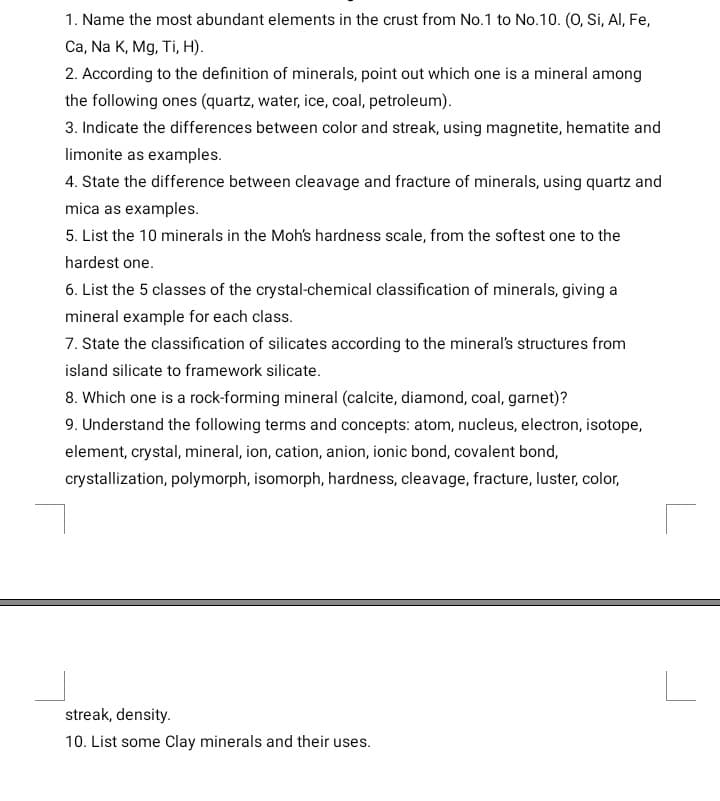1. Name the most abundant elements in the crust from No.1 to No.10. (O, Si, AI, Fe, Ca, Na K, Mg, Ti, H). 2. According to the definition of minerals, point out which one is a mineral among the following ones (quartz, water, ice, coal, petroleum). 3. Indicate the differences between color and streak, using magnetite, hematite and limonite as examples. 4. State the difference between cleavage and fracture of minerals, using quartz and mica as examples. 5. List the 10 minerals in the Moh's hardness scale, from the softest one to the hardest one. 6. List the 5 classes of the crystal-chemical classification of minerals, giving a mineral evample for each clase
1. Name the most abundant elements in the crust from No.1 to No.10. (O, Si, AI, Fe, Ca, Na K, Mg, Ti, H). 2. According to the definition of minerals, point out which one is a mineral among the following ones (quartz, water, ice, coal, petroleum). 3. Indicate the differences between color and streak, using magnetite, hematite and limonite as examples. 4. State the difference between cleavage and fracture of minerals, using quartz and mica as examples. 5. List the 10 minerals in the Moh's hardness scale, from the softest one to the hardest one. 6. List the 5 classes of the crystal-chemical classification of minerals, giving a mineral evample for each clase
Chemistry: An Atoms First Approach
2nd Edition
ISBN:9781305079243
Author:Steven S. Zumdahl, Susan A. Zumdahl
Publisher:Steven S. Zumdahl, Susan A. Zumdahl
Chapter20: Transition Metals And Coordination Chemistry
Section: Chapter Questions
Problem 70E
Related questions
Question

Transcribed Image Text:1. Name the most abundant elements in the crust from No.1 to No.10. (O, Si, Al, Fe,
Ca, Na K, Mg, Ti, H).
2. According to the definition of minerals, point out which one is a mineral among
the following ones (quartz, water, ice, coal, petroleum).
3. Indicate the differences between color and streak, using magnetite, hematite and
limonite as examples.
4. State the difference between cleavage and fracture of minerals, using quartz and
mica as examples.
5. List the 10 minerals in the Moh's hardness scale, from the softest one to the
hardest one.
6. List the 5 classes of the crystal-chemical classification of minerals, giving a
mineral example for each class.
7. State the classification of silicates according to the mineral's structures from
island silicate to framework silicate.
8. Which one is a rock-forming mineral (calcite, diamond, coal, garnet)?
9. Understand the following terms and concepts: atom, nucleus, electron, isotope,
element, crystal, mineral, ion, cation, anion, ionic bond, covalent bond,
crystallization, polymorph, isomorph, hardness, cleavage, fracture, luster, color,
streak, density.
10. List some Clay minerals and their uses.
Expert Solution
This question has been solved!
Explore an expertly crafted, step-by-step solution for a thorough understanding of key concepts.
This is a popular solution!
Trending now
This is a popular solution!
Step by step
Solved in 2 steps

Knowledge Booster
Learn more about
Need a deep-dive on the concept behind this application? Look no further. Learn more about this topic, chemistry and related others by exploring similar questions and additional content below.Recommended textbooks for you

Chemistry: An Atoms First Approach
Chemistry
ISBN:
9781305079243
Author:
Steven S. Zumdahl, Susan A. Zumdahl
Publisher:
Cengage Learning


Chemistry
Chemistry
ISBN:
9781305957404
Author:
Steven S. Zumdahl, Susan A. Zumdahl, Donald J. DeCoste
Publisher:
Cengage Learning

Chemistry: An Atoms First Approach
Chemistry
ISBN:
9781305079243
Author:
Steven S. Zumdahl, Susan A. Zumdahl
Publisher:
Cengage Learning


Chemistry
Chemistry
ISBN:
9781305957404
Author:
Steven S. Zumdahl, Susan A. Zumdahl, Donald J. DeCoste
Publisher:
Cengage Learning

Chemistry: The Molecular Science
Chemistry
ISBN:
9781285199047
Author:
John W. Moore, Conrad L. Stanitski
Publisher:
Cengage Learning

Chemistry & Chemical Reactivity
Chemistry
ISBN:
9781337399074
Author:
John C. Kotz, Paul M. Treichel, John Townsend, David Treichel
Publisher:
Cengage Learning

Physical Chemistry
Chemistry
ISBN:
9781133958437
Author:
Ball, David W. (david Warren), BAER, Tomas
Publisher:
Wadsworth Cengage Learning,